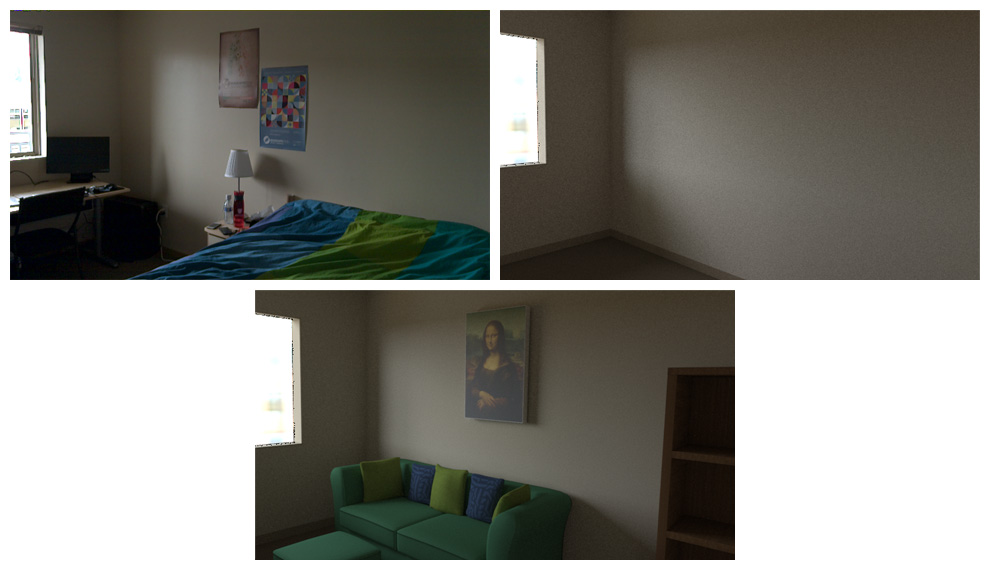Paper at SIGGRAPH Asia 2016.
Edward Zhang, Michael F. Cohen, Brian Curless. 2016. “Emptying, Refurnishing, and Relighting Indoor Spaces”. ACM Transactions on Graphics (Proceedings of SIGGRAPH Asia 2016)
Project webpage at http://grail.cs.washington.edu/projects/emptying
TL;DR
Enable visually realistic edits to indoor scenes, like removing and inserting furniture.
Abstract
Visualizing changes to indoor scenes is important for many applications. When looking for a new place to live, we want to see how the interior looks not with the current inhabitant’s belongings, but with our own furniture. Before purchasing a new sofa, we want to visualize how it would look in our living room. In this paper, we present a system that takes an RGBD scan of an indoor scene and produces a scene model of the empty room, including light emitters, materials, and the geometry of the non-cluttered room. Our system enables realistic rendering not only of the empty room under the original lighting conditions, but also with various scene edits, including adding furniture, changing the material properties of the walls, and relighting. These types of scene edits enable many mixed reality applications in areas such as real estate, furniture retail, and interior design. Our system contains two novel technical contributions: a 3D radiometric calibration process that recovers the appearance of the scene in high dynamic range, and a global-illumination-aware inverse rendering framework that simultaneously recovers reflectance properties of scene surfaces and lighting properties for several light source types, including generalized point and line lights.
Technical Overview
This system was made up of a number of independent components. I’ll go over these components briefly here.
- Capture and Preprocessing: We used the Project Tango tablet as our input device, capturing a handheld RGBD scan of the scene. Some fairly standard preprocessing of this data gives us a triangle mesh of the scene as well as camera poses for a set of color images (with autoexposure) of the scene. This process is detailed in my Capturing Scenes with the Project Tango Tablet post.
- HDR Calibration: If an area of an image is very bright compared to another area (e.g. a window compared to the rest of the room), cameras can’t accurately represent the relative brightnesses in a single image - they are low dynamic range. However, with multiple images of the scene taken at different exposure levels, it’s possible to recover accurate brightnesses in all regions of the scene. Having consistent, accurate measures of brightness is vital for inverse rendering to work. The process of obtaining a high dynamic range mesh is detailed in my 3D HDR Scene Capture post.
- Floorplan Estimation: For our particular application, we want to identify the walls, floor, and ceiling. These are the things that we can’t remove from the room, because they are the room! In this work, we use fairly strict assumptions on what shapes rooms can take (e.g. all surfaces are flat and at right angles to each other), but the outcomes of this step don’t really affect the inverse rendering process.
- Architectural Features: This step involves identifying doorways and baseboards - things that can’t be removed from the room, but don’t really affect the shape of the room. This is a fairly minor step (and doesn’t appear in the overview diagram), but it’s pretty important for making our empty room renderings actually look like rooms instead of boxes.
- Inverse Rendering: The rendering problem involves computing the appearance of a scene given the shape, surface properties (materials), and light emitters. In inverse rendering, we take the scene appearance and shape, and recovers the material and light emitter properties. In our work we assume that surfaces are diffuse and that the positions (but not intensities or angular distributions) of light sources are known. Unlike most traditional inverse rendering works, our method deals with local light sources (rather than distant light sources) and accounts for global illumination effects (such as color bleeding and shadows).
- Re-rendering: Our inverse rendering process gives us all the properties that we need to feed into a standard renderer such as Pixar’s Renderman, Blender’s Cycles, or, in our case, the Academy-Award-winning PBRT. This means that it’s easy to edit the scene by changing some of the properties that we’ve solved for, or inserting new objects, in a way that is physically accurate and self-consistent.
Data
Several of our datasets with radiometric calibration can be viewed at https://sketchfab.com/kyzyx/collections/hdr-room-scans.
More Results


Acknowledgements
We would like to thank Sameer Agarwal for his advice on optimization and Ceres Solver. We also thank Pratheba Selvaraju for her assistance in modelling the contents of refurnished scenes. These contents include 3D models from CGTrader (users scopia, den_krasik, buchak72, belgrade_sim, peter_janov) and Turbosquid (user shop3ds). Several additional 3D models were obtained from the Stanford 3D Scanning Repository.
This work was supported by the NSF/Intel Visual and Experiential Computing Award #1538618, with additional support from Google, Microsoft, Pixar, and the University of Washington Animation Research Labs.

